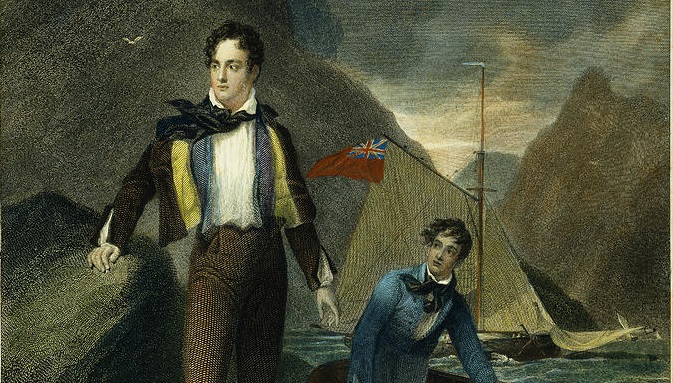.
For Better or for Worse?
Poetic genius, swallowed from a bottle;
Ingested from an opiate-filled pipe;
Imagination speeding at full-throttle;
A pleasure-domed Romantic archetype.
No LSD or fentanyl required;
No Kona Gold, Red Bull, or crack cocaine.
As Byron said, “Whenever I was tired
Laudanum, beer and wine removed the pain.”*
Did bouts of drug- and booze-induced illusion
Inspire the best of Poe and Byron’s verse?
Or did such “savage,” “quarrelsome” delusion
Exchange “what might have been”-for something worse?
Laudanum laude? Muse from heaven or hell?
Or somewhere in between? It’s hard to tell.
.
*The actual (conflated) quote from Byron, “I don’t like laudanum now as I used to do. (Beer, wine, and laudanum makes me) savage and suspicious, and even quarrelsome.” The lists of 19-century writers who used opiates such as laudanum with some frequency include Elizabeth Barrett Browning, John Keats, Lord Byron, Samuel Taylor Coleridge, Edgar Allan Poe, Charles Dickens, Bram Stoker, George Eliot, Ernest Dowson, Louisa May Alcott, Dante Gabriel Rossetti, and Percy Bysshe Shelley.
.
.
Epigram
Un-toga-ed Romans spinning in my head
Inspire descriptive words best left unsaid.
I will, like T.E. Lawrence (being well-bred)
Read Apuleius’ Golden Ass, instead.
.
.
A Bach Cantata or a Bacchanal?
To write a sonnet can be hard, no doubt.
But if I were required to make the call,
Which would be easier to write about?
A Bach cantata or a Bacchanal?
The answer’s obvious, it seems to me.
For orgiastic sexuality
With puking, pulsing, pounding flesh would be
A simple subject for one’s poetry.
The Bach cantata would take far more time
To reproduce, in measured verse and rhyme,
A subject so ethereal, sublime . . .
How can polyphony compare to slime?
To write of Bacchus? Easiest to do.
To write of Bach? The harder of the two.
.
.
James A. Tweedie is a retired pastor living in Long Beach, Washington. He has written and published six novels, one collection of short stories, and three collections of poetry including Mostly Sonnets, all with Dunecrest Press. His poems have been published nationally and internationally in The Lyric, Poetry Salzburg (Austria) Review, California Quarterly, Asses of Parnassus, Lighten Up Online, Better than Starbucks, WestWard Quarterly, Society of Classical Poets, and The Chained Muse.















James – I never realised taking laudanum was QUITE so universal in the nineteenth century, including one or two of those you mention in whose mouths, one might otherwise suspect, it would be difficult to melt butter. They were dark horses, these Victorians, as witness the usual definition of “Victorian” compared with the raunchiness of Queen Victoria herself in private. And the question with which you head your first poem? We are surely all incalculably better off for it. And thank you for the impeccably composed little “trip” to Xanadu.
A list of modern opioids from strongest to weakest reads as follows:
Fentanyl (Duragesic)
Oxymorphone (Opana ER, Numorphan)
Hydromorphone (Dilaudid, Exalgo, Contin)
Heroin (diamorphine)
Levorphanol (Levo-Dromoran)
Methadone (Dolophine, methadose)
Oxycodone (OxyContin, Roxicodone)
Tapentadol (Nucynta, Palexia SR
Morphine (Astramorph, Avinza, Kadian)
Hydrocodone (Zohydro ER)
Pethidine (Meperidine, Demerol)
Codeine
Tramadol (Ultram)
Laudanum (Opium Tincture)
In the 18th and 19th century, however, the word “Laudanum” was a synonym for Morphine, an addictive opioid which was readily available and considered to be a cure-all for many ailments, particularly diarrhea (intestinal ailments were common) and pain. It also induces sleep (opioids depress the central nervous system) and, in some people, prompts dreamlike hallucinations.
Effective pain control is a relatively recent medical development and we forget how unforgiving untreated acute and chronic pain can be. Elizabeth Barrett suffered a chronic, debilitating, undiagnosed ailment from the age of 13 and Laudanum (often generically called “opium”) was the only treatment available to her. Thomas Jefferson took it for his diarrhea and Arthur Conan Doyle’s character, Sherlock Holmes, was also addicted. When mixed with alcohol (as with Poe and Byron) it can lead to physical and mental dysfunction and death.
We should not be too quick to misjudge the use and misuse of Laudanum in the past.
All that aside, my point in the first poem is to ask whether its use made good poets better or worse. I don’t know. Peter seems to think so. What do any of you, think?
On the downside, there are records of good, budding 19th c.. poets who never became great because Laudanum (and alcohol) killed them before they had a chance to shine.
Right through the 20th century, there was a tonic for women called “Lydia Pinkham’s Solution.” It had a profile of this lady on the label, which looked EXACTLY like the image on our Susan B. Anthony dollar coin. (That’s why my father called the coin “the Lydia Pinkham dollar”).
The tonic’s original formulation was laudanum (opium dissolved in alcohol) mixed with cocaine. You wonder why all those little old ladies were smiling so much? Taking Lydia Pinkham’s Solution was like taking a speedball with a vodka chaser.
Enjoyed all three very much, Mr. Tweedie,
thank you..
Thank you, jd,
They were meant to entertain but they were also written to make a point and to raise several important questions about poetry–answers I wouldn’t have raised if I knew what the answers were!
I love your witty compositions, and all three brightened my day. Was laudanum also mixed with wine? Dr. Salemi mentions cocaine. I recall reading that back in the day, people thought that it was good for your health; and, if I’m not mistaken, the original formulation of Coca-Cola contained cocaine, hence the “Coca”! As an aside, when radium was first discovered, they thought that was healthy too, which led to products such as “radium water”.
I had forgotten about “radium water!” Perhaps 100 years from now people will look at our present understanding of medicine and think of it as primitive, naive and mistaken, much as we tend to do when we look to our own past.
The original Coca-Cola, as made in Georgia back in the 1890s, did have cocaine in it, since the drug was considered very healthful (Sigmund Freud thought so, and recommended it to his fiancee). But cocaine was removed from the soft drink sometime in the early years of the 20th century, after the regulations of the Pure Food and Drug Act. Another example of obnoxious governmental busybodies.
Mr. Tweedie, thank you for these three sparkling gems of wit and wisdom to light up a dark, November afternoon over here. I now have a mental image of un-toga’d Romans orgying away, accompanied by Bach. I often think it discourteous to reply in verse, but thinking of Kubla Khan,I just couldn’t help myself.
I am the man from Porlock,
You can put the blame on me.
For interrupting Samuel,
In his joyful reverie.
For it was I, supplying him,
With all that dope he used.
That rendered him incapable,
Be-fuddled and bemused.
His poem may have been too long,
For folk like us to bear.
So Mr. Taylor-Coleridge,
Aren’t you glad I stopped you there?
Lol, Jeff,
And here’s a fun connection. The Greeks had a god of laughter named Gelos. He was a companion of Dionysus (Roman, Bacchus) and we know of his real or imagined festival in Thessalonica (the same place named in two of St. Paul’s letters) because Apuleius mentions it in “The Golden Ass.”
I mention this because your short poem re STC made me laugh.
Dear James –
Exdellent ! I enjoyied them very much. I’m all for Bach ovwer the other.
Ben Franklin helped to draft the Declaration of Independence and US Constitution and took Laudanum for a severe pain from a bladder stone. Used correctly I think the person using strong narcotics can retain their intelligent brain. I don’t believe the drugs made anyone a poet. Thank you for your poems
Norma, We are of the same mind.
Though I regard self-medication as a natural right, James, such a large dose of truth (your poems provide) all at once unsettles the mind, and I am quite comfortable with my addiction to it. So I thank you Dr. Tweedie.
James, after seeing your list, I had to recall that sick animals usually refuse anything. Whereas most persons our age have at least twelve daily pill bottles and 38 injections prescribed supposedly to prevent whatever might go wrong. Your set of poems on a small part of the subject is witty and welcome.